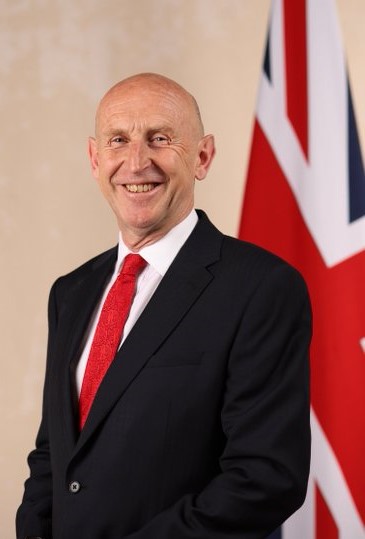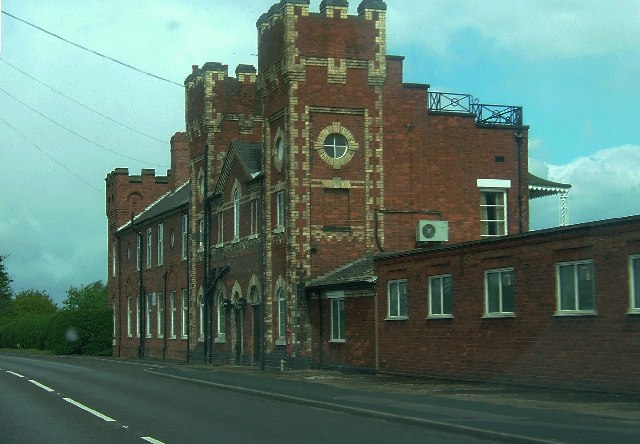|
Gamecock Barracks
Gamecock Barracks is a British Army installation located at Bramcote, south-east of Nuneaton in Warwickshire. History The barracks was established on the site of the former RAF Bramcote airbase in 1959. It was named after HMS ''Gamecock'', the naval ship name given to the airbase by the Royal Navy before the British Army took over. The barracks were home to the Junior Leaders' Regiment Royal Artillery between the 1960s and the 1990s, which was a training establishment for the future non-commissioned officers of the Royal Artillery. It was one of many different types of Junior establishments for soldiers serving from the age of 15 to 17 years (until the school leaving age was raised to 16). After completing their military and trade training, which initially took two years, but was latterly reduced to 12 months, they would muster to their designated Field Army artillery regiments. In 1993, 30 Signal Regiment moved to the barracks. The regiment's personnel are held at very high n ... [...More Info...] [...Related Items...] OR: [Wikipedia] [Google] [Baidu] |
Ministry Of Defence (United Kingdom)
The Ministry of Defence (MOD or MoD) is a Departments of the Government of the United Kingdom, ministerial department of the Government of the United Kingdom. It is responsible for implementing the defence policy set by the government and serves as the headquarters of the British Armed Forces. The MOD states that its principal objectives are to defend the United Kingdom of Great Britain and Northern Ireland and its interests and to strengthen international peace and stability. The MOD also manages day-to-day running of the armed forces, contingency planning and defence procurement. The expenditure, administration and policy of the MOD are scrutinised by the Defence Select Committee, except for Defence Intelligence which instead falls under the Intelligence and Security Committee of Parliament. History During the 1920s and 1930s, British civil servants and politicians, looking back at the performance of the state during World War I, concluded that there was a need for greater ... [...More Info...] [...Related Items...] OR: [Wikipedia] [Google] [Baidu] |
Royal Artillery
The Royal Regiment of Artillery, commonly referred to as the Royal Artillery (RA) and colloquially known as "The Gunners", is one of two regiments that make up the artillery arm of the British Army. The Royal Regiment of Artillery comprises thirteen Regular Army regiments, King's Troop, Royal Horse Artillery, the King's Troop Royal Horse Artillery and five Army Reserve (United Kingdom), Army Reserve regiments. History Formation to 1799 Artillery was used by English troops as early as the Battle of Crécy in 1346, while Henry VIII established it as a semi-permanent function in the 16th century. Until the British Civil Wars, the majority of military units in Britain were raised for specific campaigns and disbanded when they were over. An exception were gunners based at the Tower of London, Portsmouth and other forts around Britain, who were controlled by the Ordnance Office and stored and maintained equipment and provided personnel for field artillery 'traynes' that were org ... [...More Info...] [...Related Items...] OR: [Wikipedia] [Google] [Baidu] |
Defence Medical Services
The Defence Medical Services (DMS) is an umbrella organisation within the Ministry of Defence in the United Kingdom. It describes the Royal Navy Medical Service, Army Medical Services and RAF Medical Services. The Defence Medical Services Group and Headquarters DMS is part of Strategic Command, although with the exception of civilian staff, the personnel contained in it are each part of their respective three Services. Structure The Defence Medical Services are led by the Director General, currently Air Marshal Clare Walton. The Director General DMS is the defence authority for end to end Defence healthcare and medical operational capability. The Defence Medical Services Group also has three two-star directors: * Surgeon General and Defence Medical Director * Director of Medical Personnel and Training ** The Medical Personnel and Training Directorate includes the Defence Medical Academy, which delivers medical education and training, and the Joint Hospital Group, which ... [...More Info...] [...Related Items...] OR: [Wikipedia] [Google] [Baidu] |
Whittington Barracks
DMS Whittington, otherwise known as Defence Medical Services Whittington (formerly Whittington Barracks), is a military base in Whittington, Staffordshire, near Lichfield in England. It is home to the Staffordshire Regiment Museum, the Headquarters of the Surgeon General and subordinate medical headquarters, and the location of the Defence Medical Academy. Early history The barracks were constructed on Whittington Heath. The heath had been the site of the Lichfield races which had moved from Fradley in 1702. During the 18th century they were one of the largest and well attended race meetings in the Midlands and in 1773 a grandstand was erected near the Lichfield- Tamworth Road. However, during the 19th century the popularity of the races dwindled, and military use of the heath grew. The War Office approached the Marquess of Anglesey in 1875 to buy the heath for the building of a barracks. Construction started in 1877 and the formal handing over of the newly built barracks to t ... [...More Info...] [...Related Items...] OR: [Wikipedia] [Google] [Baidu] |
Chetwynd Barracks
Chetwynd Barracks is a British Army installation at Chilwell, Nottinghamshire, England. HMS ''Sherwood'', a Royal Naval Reserve stone frigate, is located within the barracks. The site will close in 2026. History British Army The Chilwell depot and barracks were built for the Royal Army Ordnance Corps shortly after the First World War on the former site of the National Shell Filling Factory, Chilwell which had been completely devastated by an explosion in July 1918. The site continued to be used as a central ordnance depot after the Second World War and, although the central vehicle kit store closed in 1958, when operations moved to Bicester, it continued to operate as a general stores depot and a vehicle workshop. The site was renamed Chetwynd Barracks, after Viscount Chetwynd who had been Managing Director of the National Shell Filling Factory, in 1995 and became the home of 49 (East) Brigade. Under Army 2020, 49 (East) Brigade was merged with 7th Armoured Brigade to beco ... [...More Info...] [...Related Items...] OR: [Wikipedia] [Google] [Baidu] |
Queen's Gurkha Signals
The Queen's Gurkha Signals (QG SIGNALS) is a regular unit of Royal Corps of Signals, one of the combat support arms of British Army. Together with the Queen's Gurkha Engineers, the Queen's Own Gurkha Logistic Regiment, the Royal Gurkha Rifles, and a number of smaller support units, they form part of the Brigade of Gurkhas. QGS was formed during Malayan Emergency, The Malayan Emergency to support the 17th Gurkha Division. History The history of Queen's Gurkha Signals dates back to 1911 when Gurkha Signallers were employed in the three Indian Corps of Sappers and Miners (Bombay, Bengal, and Madras). It was not until the First World War the whole companies of Gurkha signallers existed within these three Corps. Eventually at the end of 1928 these corps were phased out of service due to an insufficient work force. The second Gurkha Signals unit was created during Malayan Emergency, The Malayan Emergency. The unit was raised to support the Gurkha Infantry involved in battle against comm ... [...More Info...] [...Related Items...] OR: [Wikipedia] [Google] [Baidu] |
Standing Joint Force Headquarters
The Standing Joint Force Headquarters (SJFHQ) is a rapidly deployable component that provides operational command and control to the Joint Expeditionary Force and the Combined Joint Expeditionary Force (Anglo-French alliance) when on small and medium-sized operations. The headquarters is responsible to the Chief of Joint Operations through the Chief of Staff (Operations). The Joint Force Headquarters (JFHQ) and Joint Force Logistics Component Headquarters (JFLogC) both come under the command of the SJFHQ Commander and are based at Northwood Headquarters. References Military units and formations of the United Kingdom Military headquarters {{UK-mil-unit-stub ... [...More Info...] [...Related Items...] OR: [Wikipedia] [Google] [Baidu] |
British Army
The British Army is the principal Army, land warfare force of the United Kingdom. the British Army comprises 73,847 regular full-time personnel, 4,127 Brigade of Gurkhas, Gurkhas, 25,742 Army Reserve (United Kingdom), volunteer reserve personnel and 4,697 "other personnel", for a total of 108,413. The British Army traces back to 1707 and the Acts of Union 1707, formation of the united Kingdom of Great Britain which joined the Kingdoms of Kingdom of England, England and Kingdom of Scotland, Scotland into a Political union, single state and, with that, united the English Army and the Scots Army as the British Army. The Parliament of England, English Bill of Rights 1689 and Convention of the Estates, Scottish Claim of Right Act 1689 require parliamentary consent for the Crown to maintain a peacetime standing army. Members of the British Army swear allegiance to the Charles III, monarch as their commander-in-chief. The army is administered by the Ministry of Defence (United Kingd ... [...More Info...] [...Related Items...] OR: [Wikipedia] [Google] [Baidu] |
Royal Corps Of Signals
The Royal Corps of Signals (often simply known as the Royal Signals – abbreviated to R SIGNALS) is one of the combat support arms of the British Army. Signals units are among the first into action, providing the battlefield communications and information systems essential to all operations. Royal Signals units provide the full telecommunications infrastructure for the Army wherever they operate in the world. The Corps has its own engineers, logistics experts and systems operators to run radio and area networks in the field. It is responsible for installing, maintaining and operating all types of telecommunications equipment and information systems, providing command support to commanders and their headquarters, and conducting electronic warfare against enemy communications. History Origins In 1870, 'C' Telegraph Troop, Royal Engineers, was founded under Captain Montague Lambert. The Troop was the first formal professional body of signallers in the British Army and its dut ... [...More Info...] [...Related Items...] OR: [Wikipedia] [Google] [Baidu] |
Royal Navy
The Royal Navy (RN) is the naval warfare force of the United Kingdom. It is a component of His Majesty's Naval Service, and its officers hold their commissions from the King of the United Kingdom, King. Although warships were used by Kingdom of England, English and Kingdom of Scotland, Scottish kings from the early Middle Ages, medieval period, the first major maritime engagements were fought in the Hundred Years' War against Kingdom of France, France. The modern Royal Navy traces its origins to the English Navy of the early 16th century; the oldest of the British Armed Forces, UK's armed services, it is consequently known as the Senior Service. From the early 18th century until the World War II, Second World War, it was the world's most powerful navy. The Royal Navy played a key part in establishing and defending the British Empire, and four Imperial fortress colonies and a string of imperial bases and coaling stations secured the Royal Navy's ability to assert naval superior ... [...More Info...] [...Related Items...] OR: [Wikipedia] [Google] [Baidu] |
Stone Frigate
A stone frigate is a naval establishment on land. 'Stone frigate' is an informal term which has its origin in Britain's Royal Navy (RN), after its use of Diamond Rock, an island off Martinique, as a 'sloop of war' to harass the First French Empire, French in 1803–1804. The Royal Navy was prohibited from ruling over land, so the land was Ship commissioning, commissioned as a ship. The command of this first stone frigate was given to Sir Samuel Hood, 1st Baronet, Commodore Hood's first lieutenant, James Wilkes Maurice, who, with cannon taken off the Commodore's ship, manned it with a crew of 120 until its capture by the French in the Battle of Diamond Rock in 1805. Until the late 19th century, the Royal Navy housed training and other support facilities in Hulk (ship type), hulks; old wooden ships of the line, moored in ports as receiving ships, depot ships, or floating barracks. The British Admiralty, Admiralty regarded shore accommodation as expensive, and liable to lead to ... [...More Info...] [...Related Items...] OR: [Wikipedia] [Google] [Baidu] |



